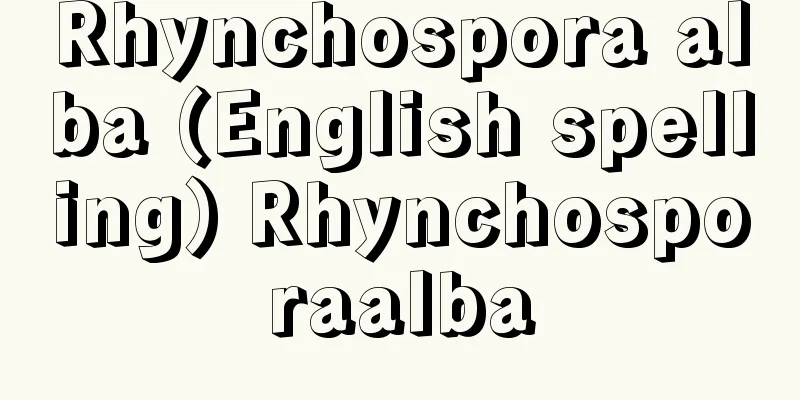Japanese clothing - wafuku

|
It is a general term for traditional Japanese clothing that has come to be called Japanese national clothing in recent years. Western clothing was imported in the Meiji period and was called Western clothing. In contrast, traditional Japanese clothing came to be called wafuku. Generally, wafuku is associated with the term "kimono," and is used as a synonym for kimono. Wafuku is clothing that developed in Japan, and in the broadest sense it refers to all styles of clothing that have been used in Japan since ancient times, but in the narrowest sense it includes long kimono, haori, obi, long undergarment (juban), hadajuban, susoyoke, coats, and for men, hakama and fundoshi, as well as tabi and footwear as Japanese accessories. [Yasu Fujimoto] kindsLong coat and haoriA kimono consists of sleeves, a body, a collar, and a matching collar. The lining of a women's lined kimono consists of a lining and a hem, with wipes at the cuffs and hem. Men's kimonos have a continuous lining, with a separate piece of fabric used for the cuffs. A haori consists of sleeves, a body, a collar, a gusset, and an inner hem. The front body is cut to fit the cuffs and gusset. A regular width collar is used as is, and is folded to fit the collar width. Awase haori has a hem that is folded back to create a loop at the top. Patterned fabrics are often used for the body lining. Men's haori use a forehead lining, which is dyed with landscape paintings or auspicious patterns of the first dream. [Yasu Fujimoto] Long undergarmentA nagajuban consists of sleeves, a body, and a collar, and the collar is attached to the hem. Flashy patterns and colors are chosen to reflect the aesthetic sense of using elaborate underwear. For men's undergarments, the back of the body is dyed with a pictorial pattern similar to that of the forehead lining, and there is no seam on the back. The sleeves of the lined kimono are unlined for both men and women. The undergarment is made of bleached cloth that is moisture-absorbent and warm, and reaches down to the waist. The collar and sleeves are also narrow so that they cannot be seen from the cuffs. The sleeves have openings under the sleeves, and there is a waist-high opening and a horse-riding tab at the side. The susoyoke is underwear that covers the lower half of the body, and is made of a fabric that allows for easy movement of the legs. The hanjuban corresponds to the upper half of the nagajuban, and the hanjuban and susoyoke are worn in place of the nagajuban. [Yasu Fujimoto] bandThe obi is an indispensable part of Japanese clothing, especially for girls. It is the only thing that adds beauty to formal attire such as black tomesode, colored tomesode, furisode, and houmongi for everyday wear, as well as wedding receptions, coming-of-age ceremonies, theater, tea ceremonies, and dance. It is said that an obi of a higher value than a long kimono enhances the effect of Japanese clothing. Depending on the purpose of wearing it, a good color scheme is chosen from among the Maru obi, Fukuro obi, Nagoya obi, and Fukuro Nagoya obi. A half-width obi is used with a yukata. Boys can choose to wear either a Kaku obi or a Heko obi. A Kaku obi is used for formal attire. For children, girls wear an obi to celebrate the ages of 3 and 7, and in Kyoto and other areas, 13. For formal occasions, a Maru obi for children is used, but in recent years, an Attached obi, which is easier to put on, has also become popular. [Yasu Fujimoto] CoatThere are various types of coats, for protection from dust, cold, rain, and fashion. For men, the kakusode coat is used. From the Meiji period until before the Second World War, the double-layered (tonbi) coat was commonly used. Haiku poets, tea masters, and elderly people also wear doyuki coats. Women's coats are worn in a variety of ways. In particular, in recent years, young people have begun to wear coats with formal wear and coats with street wear instead of haori, without wearing haori. For women, the main part of the coat is a long kimono with an obi belt, whether formal or ceremonial, so coats have become familiar to people who do not usually wear Japanese clothing as a way to protect against dust and cold. In recent years, doyuki coats have become colorful and patterned, and the number of people wearing single doyuki half coats has increased, and fabrics such as sha and ra are used. Sha and ra fabrics are also used for summer rain goats. [Yasu Fujimoto] HakamaHakama are an indispensable part of boys' formal attire, along with haori, and bunari-hakama (hori-hakama) are used. Girls wore hakama when they did not have an obi, but this was mainly for students who wore kimono to school. They were also worn for school ceremonies, but after World War II they were no longer seen. However, in recent years, hakama have been revived for graduation ceremonies. [Yasu Fujimoto] historyThe current form of kimono can be traced back to the appearance of the kosode obi of the Muromachi period. Kosode was named after the small sleeves, as opposed to the o-sode clothing worn in the Heian period. These kosode were tubular sleeve garments worn as undergarments under o-sode garments by the upper classes from the middle of the Heian period, but as the years passed, the sleeves became rounded and longer, until they reached the length of the Genroku sleeves of today. The color of the kosode that originated as undergarments was white. The upper classes of nobles and samurai wore a two-piece garment consisting of o-sode garments layered over hakama, and a one-piece garment over the top. In other words, two-piece and one-piece garments were used in combination at that time. Ordinary people and children wore a short one-piece garment with tubular sleeves as the outer garment, and on top of that they either wore a short wamo (upper skirt) around the waist or a thin string-like thing. This commoner's clothing has a pattern on it. During the war-torn Muromachi period, goods were scarce, and the upper classes tended to dispense with the outerwear of their obi-sleeved kimonos. Kosode, which had been worn as undergarments, became outerwear. They were long and worn with a narrow obi tied around the waist, creating a casual look. As kosode became outerwear, woven and dyed patterns appeared, and designs became more elaborate. Woven patterns were created by applying the sophistication of techniques such as twill, double-layered weaving, and brocade weaving that had been used in the Nara and Heian periods. Furthermore, the Nanban culture was imported at the time, and under this influence, patterns that were different from the traditional patterns were woven and worn for kosode. It was around this time that pattern configurations that would have an impact on later generations appeared. Different woven patterns on each half of the kosode, patterns with different colors, checkered woven patterns, and tiered patterns with colors combined in tiers were used. This can still be seen in Noh costumes today. The dyeing method used was Tsujigahana dyeing, which combines dyeing with sewn-in tie-dyeing and ink drawing. This was used on kosode and tofu from the Momoyama to the beginning of the Edo period, and then disappeared. However, after World War II, a restoration of Tsujigahana dyeing, which disappeared for a short period and was called a phantom dyeing, was made public through the efforts of Kubota Itchiku (1917-2003). The unique and gorgeous "Itchiku Tsujigahana" has a different feel from the Tsujigahana dyeing of the Muromachi and Momoyama periods, and adds color to today's kimono dyeing. In the Momoyama period, surihaku and nui (embroidery) were further used to decorate kosode, and in the Edo period, tie-dyeing was added to this. Following the partition technique, embroidery and tie-dyeing (hitta = kanoko) were done within the partitions, and the fabric was filled with surihaku to create a gorgeous kosode called "ji-nashi". However, in the great fire of Meireki 3 (1657), Edo was completely burned down, and in the aftermath, it was impossible to make many new clothes at once. At the beginning of the Kanbun era (1661-1673), there was no room for elaborate techniques on costumes. As a result, detailed patterns were hidden, and this is where the unprecedented characteristic kosode was born. The entire front of the kosode was a single pattern, with the pattern covering seven-tenths of the total, and the remaining third was left blank. The pattern was placed at the top of the right shoulder and ran from the left shoulder to the right hem, and the remaining third was left blank on the back and left hem. Embroidery and kanoko shibori were used for the pattern. This is called the Kanbun pattern, or Kanbun kosode. The pattern of the current kimono is influenced by this pattern composition. At that time, the use of gold thread was prohibited, and colored thread embroidery was allowed. During the Jokyo and Genroku periods (1684-1704), this style developed into gorgeous kosode patterns using Yuzen dyeing, embroidery, and shibori. People glorified the peaceful world and indulged in luxurious lifestyles, but excessive extravagance was suppressed by bans and other measures, and extravagance was transferred to the lining of clothing and then to underwear. Furthermore, the patterns on kosode changed from the entire garment to high-waisted patterns, hem patterns, fuki patterns, and lining patterns. Today's hem patterns, all-over patterns, tsukesage patterns, and other patterns with painted feathers have been handed down from the Edo period. Furthermore, the komon patterns used on kamishimo (traditional Japanese formal kimono) are now called Edo komon and are used on women's kimonos. Boys' kosode were mainly striped or plain, and the fabrics used included habutae, dragon crest, tsumugi, Ueda stripes, itorijima, tsumugi stripes, and tozan. Formal wear had a formal crest. When a samurai wore a kamishimo, he was required to wear a noshime kosode. Today, noshime patterns are used on the haori and hakama worn by five-year-old boys during the Shichigosan celebration, and on the hanging kimono worn by boys who are one month old when they visit a shrine. Noshime was worn only by boys. When kosode first became outerwear, they were full-length, but as they gradually grew longer, they began to be pulled down. By the mid-Edo period, they were no different from the kimono we see today. During the Edo period, a time of peace, kimonos developed into more extravagant and stylish items, and kosode began to be differentiated by the fabric they were made of. Those made from linen were called katabira, those made from cotton were called nunoko, and those made from silk were called kosode. People tried to wear clothes that suited each season, such as hitoe in summer, awase in spring and autumn, wadding in winter, and gogi when changing from season to season. This was called koromogae, and this custom was passed down until before World War II. Depending on how they were worn, they were also called katsugi, kosode, uchikake, and koshimaki. The length of the kosode became longer, so the hem was pulled up indoors, and when going out, the length was pulled up shorter and a sash or haori was tied to make it easier to walk. This was called "karageru," and even today, this technique is used to shorten the hem when it rains to keep it from getting wet. Eventually, this karage took on the form of the current ohashiori. From the end of the Edo period to the Meiji period, ohashiori came to be worn both indoors and outdoors, and the practice of pulling the hem up indoors, "ohikiduri," disappeared. In the Muromachi, Momoyama and early Edo periods, narrow kukeobi obi were used to tie kosode, but by the mid-Edo period, the width and length of the obi had become slightly wider and longer, and kichiya and mizuki tying styles were developed. As the length of kosode increased, the width of the obi also became wider, and by the late Edo period, it had become the same as the width of the obi today, and taiko tying styles were used, along with the use of obiage and obidome. The obi was originally a round obi, but in the late Edo period, haraawase obi (day and night obi, whale obi) was used, and was used until the Meiji, Taisho and early Showa periods. Around the mid-Taisho period, the Nagoya obi was invented and came to be used in place of the haraawase obi. At that time, fukuro obi was already being woven, but it became popular after World War II, and nowadays it tends to be used in place of the maru obi. However, the maru obi is superior in terms of weight and status. In summer, single obi was mainly used, but in recent years, fukuro Nagoya obi has tended to be used instead. For men, kakuobi were mainly made of quilted fabric, but nowadays, fukuro woven kakuobi are used instead. In the Meiji period, heko obi was used for everyday wear with andon hakama (loinless hakama) and kimono. [Yasu Fujimoto] Kimono fabricJapanese fabrics for outerwear, underwear, outerwear, obi, etc. vary in color, pattern, and fabric depending on gender, age, season, rank, and purpose. Because Japanese clothing has a fixed shape, the wearer's personality and seasonal feeling are expressed through the choice of fabric, color, and pattern. There is a wide variety of Japanese fabrics, the result of Japan's unique climate, customs, temperament, and accumulated traditional techniques, but the colors and patterns change from year to year. There are trends from year to year, but it is wise not to be too influenced by them. Japanese clothing has a long lifespan. The key is to choose colors and patterns that you will not tire of and good fabrics. Silk fabrics used for summer kimonos, haori, and obi include ro and sha, while for single-layer and lined kimonos, crepe, rinzu, rinzu crepe, omeshi, habutae, and tsumugi are used. For the cuffs of men's lined kimonos, black Hachijo is used, and for obi fabrics, Nishiki weave, Karaori, Shuchin, Hakata, Shiose, Habutae, and Tsumugi are used. For hakama, Sendaihira, Yamabe Satohira, Gosenhira, and Hakatahira Tsumugi are used. For coats, gauze, ra, crepe, variegated pattern weave, saushi, monshuushi, and tsumugi are used. Linen fabrics are called joufu, and examples include Ojiya chijimi (Echigo chijimi, Echigo joufu), Yaeyama joufu (Satsuma joufu), and Noto joufu. Cotton fabrics include striped cotton, kasuri cotton, yukata fabric (Oka cotton), and cotton chijimi. For undergarments, there is bleached cotton, and for linings there is kanakin or shin moss, and for men's cuff fabrics there is cotton kurohachi. Woolen fabrics include muslin, wool, and flannel. In recent years, advanced synthetic fiber fabrics have also been produced. The weave is no different to cotton, wool, or silk fabrics, and the dyeing is no different to silk fabrics; only the materials are different. There are two types of dyeing: yarn-dyed and end-dyed; obi for formal wear and ceremonial occasions are yarn-dyed woven, while end-dyed obi for fashionable or leisure occasions are used. Fabrics for kimonos are selected according to the season, rank, gender, and purpose, but end-dyed fabrics are used for formal wear and ceremonial occasions. Colors include plain and patterned. Indigo dyed yukata is particularly popular in summer, pale colors in spring, and darker colors in autumn and winter, with selections made according to the season and the fashionable colors. Patterns include stripes, kasuri, and lattice patterns, as well as a wide variety of patterned weaves. Woven fabrics for ground patterns can be dyed in plain colors, small patterns and other patterns, or patterns created with eba-tsuke, depending on the purpose. [Yasu Fujimoto] Tailored dimensionsThe long kimono, haori, and nagajuban are divided into men's and women's kimonos, children's and adults' kimonos, and seasonally there are single-layer kimonos worn mainly in the summer and lined kimonos worn mainly in the winter. The size and shape of children's kimonos vary slightly from infants to children as they grow. Today, single-layer, three-layer, and four-layer kimonos are used, and each has different cutting and sewing methods. Also, because children are in a growth period where they grow about 10 centimeters a year, they are made to be raised at the shoulders and waist, and to be able to adjust the length of the sleeves and the length of the body as they grow. Nagagi for adult men are tsuitake in length, have sleeves with sleeves that are long and have a narrow collar (bo-eri). To allow for alterations, the hem is placed near the waist, below the obi. Nagagi for women are made longer than the overall length of the garment, and this is considered the full length. Sleeves come in Genroku sleeves, long sleeves (sleeve sleeves), and furisode (small furisode, medium furisode, large furisode). Genroku sleeves are 42-45cm long, have slightly smaller cuffs at 20cm, are rounded at 8-10cm, and are considered to have a sporty feel. The length of long sleeves varies depending on age and purpose. For young people, the sleeve length is 53-55 cm, for middle-aged people and older, 47-49 cm, and for young people's formal wear and formal kimono, the sleeve length is 60-65 cm. The sleeve length varies depending on age, but also on where the obi is tied. Generally, young people tie their obi higher, so the sleeve length for yukata is 22 cm, for formal kimono, 20 cm, and for furisode, 19 cm. For middle-aged people and older, the sleeve length is fixed at about 23 cm, and for older people, it is about 24-25 cm. For yukata, the collar is a bat-collar (wide collar), and for thin fabrics, silk, and wool, both lined and hitoe are wide collars. Nagagi worn for tea ceremonies, dance training, etc. are made with longer sleeves and wider width to make it easier to move and not to come undone. Careful attention is required according to the purpose of wearing, and with consideration, a kimono can be made easy to wear. All Japanese clothing is made of rectangular pieces of cloth sewn together, with gentle straight lines. When worn, it takes on a curved shape, and expresses dynamic beauty as the wearer walks and moves. Body types vary from obese to skinny, hunched backs, and arched bodies, but kimonos are said to be like wrapping cloths that wrap around the body, and as long as the differences in body types are not extreme, the same length of kimono can be worn by anyone. However, the ideal comfortable kimono must be tailored to the wearer's measurements. This means that measurements of the length, sleeve length, and waist circumference (the maximum measurement of the waist) are required. The length of the kimono is determined by the body length, the sleeve length by the sleeve width and shoulder width, and the waist circumference by the body width. The dimensions of the kimono are determined by the kimono's unique rolled-up, cylindrical shape. Japanese clothing is a layered style of garment, with a long kimono at the center. The size of the haori and long undergarment are determined based on the size of the long kimono, taking into consideration the increase or decrease in thickness and the change in size when worn. It is important that the length and width of the sleeve length, sleeve width, sleeve attachment, sleeve opening, sleeve length, and sleeve opening are all the same when worn, and that the collar, shoulder opening, and sleeve opening are neatly aligned and overlap when worn. [Yasu Fujimoto] othersFeaturesBecause kimonos are cut in straight lines, they can be washed, re-sewn, and re-tailored repeatedly. Those that are dirty or faded, or that no longer suit the wearer's age, can be re-dyed and restored. Fabrics that cannot be re-dyed, such as pre-dyed fabrics, can be reused as hanten jackets or futons. In this way, kimonos have the unique feature of being able to maintain their lifespan and be passed down from parent to child, and from child to grandchild, for as long as there is a possibility of wearing them, with just a little care. Furthermore, kimonos have the advantage of hiding and beautifying the body. In addition, because they are wrapped around the body in a cylindrical shape, they are particularly suitable for keeping the lower half of the body warm and preventing cold. If the obi belt of kimonos is simplified, they are easy to put on and take off, and they are suitable for sick people and easy to care for. [Yasu Fujimoto] Congratulatory gifts, Condolence giftsFor funerals, black with five crests is worn. The fabric used varies depending on custom - habutae in Kanto and crepe in Kansai. Before World War II, it was called white collar crest, and white underwear was worn with two layers of clothing and a single collar, but after the war, two layers came to be disliked as it was believed to lead to "two misfortunes overlapping," and the trend shifted to wearing only one layer. The obi, obiage, and obijime are all black. For close relatives, the obiage and obijime are white. For both celebrations and funerals, boys wear haori and hakama (with linings). Crests are worn on formal and formal attire. For women, black tomesode, colored tomesode, and furisode are used depending on the occasion, but for formal attire, dyed crests are used, and formal attire has five crests, or three crests for short. For plain-colored kimonos and Homongi, one crest is used with a sewn crest. For men, both long kimonos and haori, five dyed crests are the formal style, and they are never abbreviated. [Yasu Fujimoto] current situationBecause Japanese clothing has a straight line and a fixed shape, it is not possible to expect the wide variety of ready-made products available, like Western clothing, that can be tailored to the color, pattern, size, and taste of the wearer. What is considered to be established as ready-made products at present are yukatas for nightwear, coats, cotton-padded tanzen, and hanten. There are also woolen hito-nagagi, haori, mourning clothes, and nagajuban, but most of these are machine-sewn. Traditionally, Japanese clothing is made by hand, as it can be repurposed and re-dyed over the lifespan of the fabric. [Yasu Fujimoto] "Kimono Cultural History" by Kawabane Sanehide (1966, Kajima Institute Publishing Association)" ▽ "Kimono - How to Choose and Wear" edited by Kujiraoka Akiko (1967, Bungeishunju) ▽ "Japanese Art 26: Clothing" edited by Hinonishi Sukeyasu (1968, Shibundo) ▽ "Japanese Art 67: Kosode" edited by Kamiya Eiko (1971, Shibundo) [Reference items] | | | | | |©Shogakukan "> Names of each part of men's lining ©Shogakukan "> Names of the parts of a women's kimono ©Shogakukan "> Names of each part of a lined haori (men's large cut haori) ©Shogakukan "> Names of each part of a lined haori (women's large cut haori) ©Shogakukan "> Names of each part of a kimono ©Shogakukan "> Names of each part of a hanjuban ©Shogakukan "> Names of each part of a kimono undergarment ©Katsuya Nishikawa "> Names of each part of the Doyuki coat (Doyuki square-collared half-coat… ©Shogakukan "> Names of each part of the horse riding hakama ©Shogakukan "> How to fold a kimono (hon-tami) ©Shogakukan "> How to fold a haori (hon-tsumami) ©Shogakukan "> How to fold a kimono undergarment and a coat ©Shogakukan "> How to fold the obi ©Shogakukan "> How to fold hakama Source: Shogakukan Encyclopedia Nipponica About Encyclopedia Nipponica Information | Legend |
|
日本在来の衣服で、近年来、日本の民族衣装とよばれているものの総称である。明治に西洋の衣服が輸入され、これを洋服とよんだ。これに対して従来の日本の衣服を和服とよぶようになった。一般に和服といえば「着物」という印象で、和服=着物の同義語として用いられている。和服は日本で発達した衣服で、広義には日本で古くから用いられてきた様式の衣服すべてをさすが、狭義には長着、羽織、帯、長襦袢(じゅばん)、肌襦袢、裾除(すそよ)け、コート、男子にはさらに袴(はかま)、褌(ふんどし)を含み、ほかに和装具として足袋、履き物などが加わる。 [藤本やす] 種類長着と羽織長着は袖、身頃(みごろ)、衽(おくみ)、衿、共衿とで成り立つ。女物袷長着の裏は胴裏と裾回しで成り立ち、袖口と裾にふきを出す。男物は通し裏で袖口布には別布を用いる。羽織は袖、身頃、衿、襠(まち)、乳(ち)とで成り立つ。前身頃はその幅から袖口布、襠の分を裁ち落とす。衿は並幅をそのまま用い、衿幅の寸法に折り畳んでつける。袷(あわせ)羽織は裾を折り返し裾山を輪とする。胴裏には柄物(がらもの)を多く用いる。男物羽織は額裏といって山水画、初夢の吉祥模様などを染め出したものを用いる。 [藤本やす] 長襦袢長襦袢は袖、身頃、衿とからなり、衿は裾までつける。下着に凝ったものを用いるという美意識から柄、色のはでなものが選ばれる。男物は、後ろ身頃に額裏同様の絵画的模様を染め出したものを用い、背に縫い目をつけない。袷の袖は男女ともに無双袖にする。肌襦袢は吸湿性、保温性のある晒(さらし)を用い、丈は腰まで。衿幅を狭く、袖幅も狭くし、袖口から見えないようにする。袖には袖下あき、脇(わき)に身八つ口、馬乗(うまのり)をつける。裾除けは下半身を覆う下着で、足さばきをよくする布地を選ぶ。半襦袢は長襦袢の上半身に相当し、半襦袢と裾除けとで長襦袢のかわりとして着用する。 [藤本やす] 帯帯はとくに女子の場合、和服に欠くことのできないものである。普段着はもちろんのことであるが、結婚式の披露宴、成人式、観劇、茶の湯、舞踊などで、黒留袖(とめそで)、色留袖、振袖、訪問着などの盛装に、美を添える唯一のものである。帯は長着よりも一段と価値の高いものが和装の効果をあげるといわれる。配色効果のよいものを着用目的によって、丸帯、袋帯、名古屋帯、袋名古屋帯などから選ぶ。浴衣(ゆかた)には半幅帯を用いる。男子は角帯か兵児(へこ)帯のいずれかを選んで用いる。礼装には角帯を用いる。子供は女児に限って3歳、7歳、京都などでは13歳の祝いに帯を締める。正式には丸帯の子供用を用いるが、近年、着付が簡単な付け帯も多く用いられている。 [藤本やす] コートコートには塵(ちり)よけ用、防寒用、防雨用、さらにおしゃれ用の各種がある。男子用コートは角袖コートが用いられている。明治時代から第二次世界大戦前までは、二重回し(とんび)が一般に用いられていた。俳人、茶人、老年の人のなかには道行コートを着用している人もある。女物コートは各種にわたって着用されている。ことに近年、若い人は羽織を着ることなく、晴れ着にコート、街着にコートと、羽織にかわってコートが着用されるようになっている。女子は正装・礼装いずれの場合も、長着に帯の帯付きを本体としていることから、ふだん和服で過ごしていない人には、コートが防塵(ぼうじん)用、防寒用として身近になってきているからである。近年の道行コートはカラフルになり、柄物も多く、また単道行半コートの着用者も増え、布地も紗(しゃ)、羅(ら)などが用いられている。夏の雨ゴートにも紗、羅の布地が用いられるようになっている。 [藤本やす] 袴袴は男子の礼装、正装には羽織とともに欠くことのできないもので襠有袴(馬乗袴)を用いる。女子は帯付きでないとき袴を用いたが、これは主として学校へ通う和服姿の生徒であった。また学校で行われる式典に用いられていたが、第二次世界大戦後はこの姿はみられなくなった。しかし近年卒業式に袴姿が復活してきている。 [藤本やす] 歴史現在の着物の形態は、室町時代の小袖帯の姿にその源流をみる。小袖は、平安時代に着用された衣服の大袖に対して、小さい袖という意味でよばれた。この小袖は、平安時代中ごろより上層階級の大袖衣の下に肌着として用いられた筒袖衣であったが、年代を経るにしたがって、袖下に曲線の丸味がつき、さらに袖丈が長くなり、現在の元禄(げんろく)袖ほどの袖丈になってきた。下着として発生した小袖の色は白であった。上層階級の公家(くげ)、武家では、大袖衣の重ね着に袴を着用した二部形式の衣服の上に一部式の衣服を着用したのである。すなわち当時は二部、一部形式の衣服を併用した姿であった。一般の庶民、子供は筒袖の小袖形式の丈の短い一部式の衣服を表着として着用し、その上に丈の短い褶(うわも)(上裳)のようなものを腰につけているか、または細い紐(ひも)ようのものを締めている。この庶民の衣服には模様がついている。 戦乱の室町時代には物資も乏しく、上層階級においては大袖衣の表着を省いていく傾向にあって、肌着として用いられていた小袖が表着化していった。その形態は対丈で、幅の狭い細い帯を腰に締めるようになった小袖帯という着流しの姿である。小袖の表着化に伴い織り柄、染め柄をつけた小袖が現れ、意匠が凝ってくる。織り柄は奈良、平安の時代を経て用いられてきた綾(あや)、二重(ふたえ)織物、錦(にしき)織などの技法から織り柄にその精緻(せいち)を応用し、さらに当時南蛮文化が輸入され、この影響を受けて従来の模様とは異なった小袖向きのものが織られ、着用されるようになった。後世への影響をもたらした模様構成が現れたのはこのころである。小袖の半身ずつ異なった織紋様、色を違えたものの片身替(がわり)、また市松風に織り柄、色を段に組み合わせた段替わりなどが用いられた。これはいまも能衣裳にみることができる。 染めは、縫い締め絞りによる染め分けと、墨の描き絵とを用いた辻が花染めが用いられた。これは桃山から江戸時代の初めまで、小袖、胴服などに用いられ、その後姿を消した。しかし第二次世界大戦後、短い期間で姿を消して幻の染めといわれた辻が花染めの復原的創作が、久保田一竹(くぼたいっちく)(1917―2003)の努力によって世に現れた。室町・桃山時代の辻が花染めとは趣(おもむき)を異にして、個性的で華やかな「一竹辻が花」が今日の着物染色に彩りを添えている。桃山時代にはさらに摺箔(すりはく)と繍(ぬい)(刺しゅう)が小袖を彩り、江戸時代に入るとこれに絞りが加わる。区画技法の後を受けて区画の中に繍、絞り(匹田(ひった)=鹿の子(かのこ))をし、さらに空白を摺箔によって布地を埋め尽くした豪華な地無しといわれる小袖が用いられるようになった。しかし明暦(めいれき)3年(1657)の大火により江戸はことごとく焼け尽くされ、その後を受けて一時に多数の衣服を新調することは不可能であった。寛文(かんぶん)(1661~73)の初め、衣装に精緻(せいち)な技巧を施す余裕はなかった。そのため細かい模様は影を潜めることになり、ここにいままでにない特徴のある小袖が誕生した。小袖の表(おもて)全面を一模様とし、全体の七分に模様を置き、残りの三分は空白の構成であった。模様は右肩上方にポイントを置いて左肩から右裾へ、そして三分の空白は背面と左裾の方へと配置した。模様には繍箔(ぬいはく)、鹿の子絞りが用いられた。これを寛文模様=寛文小袖という。現在の着物の模様はこの模様構成の影響を受けている。当時は金糸の使用禁止に伴い、色糸刺しゅうが行れるようになっていた。貞享(じょうきょう)・元禄(げんろく)(1684~1704)には友禅染めに繍、絞りを用いての華やかな小袖模様へと展開されていった。 平和な世を謳歌(おうか)し、ぜいたくな生活に凝り、度の過ぎた華美な奢(おご)りは禁令などにより押さえられ、奢りは衣服の裏へ、下着へと移っていった。また小袖の模様は全体から腰高模様、裾模様、ふき模様、そして裏模様へと移行していった。現在の裾模様、総模様、付下(つけさ)げなどの絵羽付けによる模様は、江戸時代より引き継がれているものである。また裃(かみしも)に用いられていた小紋は、今日、江戸小紋と名づけられ女物の着物に引き継がれ、用いられている。 男子の小袖は、縞物か無地が主として用いられ、布地は羽二重、竜紋(りゅうもん)、紬、上田縞、糸織縞(いとおりじま)、紬縞、唐桟(とうざん)などがあった。礼服には定紋をつける。裃を武士が着用するときはかならず熨斗目(のしめ)小袖を着用することになっている。今日熨斗目模様は、七五三の祝いのとき、5歳の男児の羽織袴姿に、また生後1か月の宮参りの男児の懸け着物に用いられている。熨斗目は男子のみが着用した。 小袖は表着化したころは対丈であったが、しだいに身丈が長くなり裾を引くようになった。江戸中期には現在の着物の形と変わらなくなってきている。江戸時代は太平の世が続いたので華美に、またしゃれたものへと進展し、小袖も布地によって区別されるようになった。麻で仕立てたものを帷子(かたびら)、木綿で仕立てたものを布子(ぬのこ)、絹織物で仕立てたものを小袖とよぶようになり、夏は単衣(ひとえ)、春秋は袷、冬は綿入れ、季節から季節に移り変わるときは合着と、それぞれに適応するものを着衣するように心がけた。これを更衣(ころもがえ)といい、第二次大戦前までこの慣習が受け継がれてきていた。また着装の仕方によって被衣(かつぎ)、小袖、打掛、腰巻と呼び名がつけられている。身丈の長くなった小袖は、屋内では裾を引き、外出では歩きやすく身丈を短く引き上げて、しごきまたは抱え帯を締めて歩行に便利にした。これを「からげる」といい、現在でも雨のときにはこの技法を用いて短くし、雨にぬれないようにする。やがてこのからげが現在のおはしょりの形をとるようになった。幕末より明治に至って、外出時、屋内ともにおはしょりをするようになって、屋内で裾を引く「お引き摺り」はなくなった。 小袖に締める帯は、室町、桃山、江戸初期には幅の狭い絎帯(くけおび)が用いられ、江戸中期ころには幅もやや広く丈も長くなり、吉弥(きちや)結び、水木(みずき)結びなどの帯結びができた。小袖の丈が長くなったのと並行して帯幅も広くなり、江戸後期には現在の帯幅と同様になり、太鼓結びなどが用いられ、帯揚、帯留なども使用するようになる。帯は本来丸帯形式のものであるが、江戸後期に腹合(はらあわせ)帯(昼夜帯、鯨(くじら)帯)が用いられ、明治、大正、昭和初期まで用いられた。大正中ごろに名古屋帯が考案され、腹合帯にかわって用いられるようになった。そのころすでに袋帯が織られていたが、第二次大戦後普及し、昨今は丸帯にかわって用いられる傾向にある。しかし、重厚さ、格ともに丸帯が勝っている。夏には単帯が主として用いられていたが、近年、袋名古屋帯がこれにかわって用いられる傾向にある。男子の角帯は、絎(く)け仕立てのものがもっぱら用いられていたが、現在は袋織の角帯がこれにかわって用いられている。明治には、兵児(へこ)帯が行灯(あんどん)袴(襠無袴)、着流しの普段用に用いられていた。 [藤本やす] 和服地和服地は表着、下着、外被、帯など、それぞれ男女、年齢、季節、格、用途によって色、柄、布地を異にしている。和服は形が一定しているから、着る人の個性、季節感などは布地、色、柄の選び方によって表現することになる。日本独特の気候・風土、気質、伝統的技術の積み重ねによる多種多様の和服地があるが、年々色づかい、柄ゆきに変化がみられる。年によって流行もあるが、それにはあまり影響されないほうが賢明であろう。和服の寿命は長い。色、柄は飽きのこないもので布地のよいものを選ぶことである。 絹織物には夏用の長着、羽織、帯に絽(ろ)、紗(しゃ)を用い、単、袷用には縮緬(ちりめん)、綸子(りんず)、綸子縮緬、御召(おめし)、羽二重(はぶたえ)、紬(つむぎ)など。男物袷長着の袖口布に黒八丈、帯地には錦(にしき)織、唐織、繻珍(しゅちん)、博多(はかた)、塩瀬、羽二重、紬などがある。袴には仙台平、山辺里平、五泉平、博多平紬などが用いられる。コートには紗、羅(ら)、縮緬、変わり紋織、朱子、紋朱子、紬などを用いる。麻織物は上布といい、小千谷縮(おぢやちぢみ)(越後(えちご)縮、越後上布)、八重山(やえやま)上布(薩摩(さつま)上布)、能登(のと)上布などがある。綿織物には縞(しま)木綿、絣(かすり)木綿、浴衣地(岡木綿)、綿縮などがある。肌着用としては晒木綿、裏布として金巾(かなきん)、新モス、男物の袖口布に綿黒八などがある。毛織物にはモスリン、ウール、ネルなど。近年は化学繊維の織物にも高度のものが出ている。織組織は綿、毛、絹の織物と変わりなく、また染めも絹織物と変わりないようなものができており、素材だけが異なっている。 染めには先染めと後(あと)染めがあるが、礼装、正装の帯は先染めの織りのものを用い、おしゃれ用、趣味用として後染めのものを用いる。長着に用いる布地は季節、格、性別、用途などにより、それぞれに適応するものを選ぶが、礼装・正装には後染めのものを用いる。色は無地物、柄物などがある。夏は藍(あい)染めによる藍の色がとくに浴衣(ゆかた)に好まれ、春は淡い色、秋冬は色の濃いものなど、季節によって、流行色によって選んで用いる。柄は、織り柄には縞、絣(かすり)、格子のほか、紋織による多種多様のものができる。地紋として織られたものは、無地染めに、小紋柄などの柄集め、絵羽付けによる模様物などに染め、用途にあわせて用いる。 [藤本やす] 仕立て寸法長着、羽織、長襦袢は、性別で男物・女物、年齢別には子供物・大人物とがあり、季節別には夏を中心に着る単(ひとえ)仕立て、冬を中心に着る袷(あわせ)仕立てがある。子供物は、乳幼児から児童と、その成長にあわせて寸法、形態が少々異なる。今日は一つ身、三つ身、四つ身とが用いられており、それぞれ裁ち方、縫い方に異なる点がある。また子供は年間に10センチメートル内外背が伸びる成長期にあるから、肩揚げ、腰揚げをし、成長にあわせて裄(ゆき)丈、身丈を伸ばして調節することができるように仕立てる。 成人男子用の長着は、丈は対丈(ついたけ)、袖(そで)は袂袖(たもとそで)で人形があり、衿(えり)は狭衿(せまえり)(棒衿)である。仕立て替えを考えて、腰近く帯の下の位置に内揚げをする。女子の長着は、おはしょり分を着丈より長くし、これを身丈とする。袖には元禄(げんろく)袖、長袖(袂袖)、振袖(小振袖、中振袖、大振袖)の種類がある。元禄袖は袖丈42~45センチメートル、袖口はやや小さく20センチメートル、袖の丸味は8~10センチメートルとし、スポーティーな感じの袖とされる。長袖の袖丈は年齢、用途によって異なる。若い人は53~55センチメートル、中年以上は47~49センチメートル、また若い人の晴れ着、訪問着の袖丈は60~65センチメートルとするなどである。袖付け寸法は年齢によって異なるが、帯を締める位置によっても変わる。一般に若い人は帯を高めに締めるから、浴衣(ゆかた)の袖付け寸法は22センチメートル、訪問着は20センチメートル、振袖は19センチメートルと寸法を変える。中年以上の人は23センチメートルくらいで固定し、老年の人は24、5センチメートルくらいとする。衿も浴衣の場合はばち衿(末広衿)とし、薄物、絹布、ウールなどは袷、単ともに広衿とする。茶席、舞踊などの稽古(けいこ)用に着用する長着は裄丈を長めに、また身幅も広くして動作がしやすく、前がはだけないように仕立てる。着用目的に従って細やかな気配りを必要とし、心遣いによって着やすい着物にすることができる。 和服はいずれも、長方形の布を縫合した緩やかな直線的衣服である。着装することによって曲線的となり、歩行、動作に伴い動的美を表現する。体型には肥満体、痩身(そうしん)、猫背、反り身などがあり多様であるが、着物は体を包む風呂敷(ふろしき)のようなものであるともいわれるように、体格の差が極端でないときは同一長着で着装可能という融通性をもっている。しかし、理想的な着やすい着物は、着装する人の寸法にあわせて仕立てられていることが条件である。つまり、着丈、裄丈、腰囲(腰部の最大寸法)の採寸が必要となる。着丈は身丈を、裄丈は袖幅と肩幅の寸法を、腰囲は身幅の寸法をそれぞれ定める。着物の寸法設定は、着物独特の巻衣式筒型の特徴によるものである。 和服は長着を中心とする重ね着形式である。羽織、長襦袢などの寸法は、長着の寸法にあわせて厚みの増減、着装による寸法の変化を斟酌(しんしゃく)して定める。着装後の裄丈、袖幅、袖付け、袖口、袖丈、振(ふり)八つ口など、丈、幅をそろうように仕立て、着装したときに衿肩あき、くりこしがきれいにそろって重なるようにすることがたいせつである。 [藤本やす] その他特長和服は直線裁ちであるので、洗い張り、仕立て直しを繰り返して行うことができる。汚れたり色があせたもの、また年齢にあわなくなったものなどは、染め直しをして再生させることができる。先染(さきぞめ)織物などで、染め直しができないものは半纏(はんてん)、ふとんなどへと利用することもできる。こうして着物の寿命を保たせ、親から子へ、子から孫へと着用の可能性のある限り受け継いでいくことも、その心遣い一つでできるという特長をもっている。 なお、和服は、体型をカバーし美化する特長をもっている。また巻衣式筒型であるから、とくに下半身の保温に適しており、冷えを防ぐ。和服は帯を簡略化すれば着脱が便利であり、病人にも適応し看護もしやすい。 [藤本やす] 祝儀、不祝儀不祝儀には黒、五つ紋付を着る。関東では羽二重(はぶたえ)、関西では縮緬(ちりめん)と、慣習によって用いる布地が異なっている。第二次大戦前は白衿紋付といい、下着に白を用い、二枚重ね一つ衿を着用していたが、戦後は二枚重ねは「不幸が二度重なる」につながるとして嫌われるようになり、1枚を着用する方向へと変化している。帯、帯揚、帯締すべて黒を用いる。近親者の場合、帯揚、帯締は白を用いる。男子は祝儀、不祝儀いずれも羽織、袴(襠有袴)を着用する。 礼装・正装には紋をつける。女性用の黒留袖、色留袖、振袖などが場合に応じて用いられるが、礼装には染抜き紋付で、正装は五つ紋、略して三つ紋をつける。色無地、訪問着などは一つ紋で縫紋(ぬいもん)をつける。男子用は長着、羽織ともに、染抜き五つ紋付を正式とし、略すことはない。 [藤本やす] 現状和服は直線的で形態が一定しているため、色、柄、着用者の寸法、好みなどにあわせた、洋服のような多種多様な既製品化は望めない。現在既製品として定着していると思われるものは、寝巻用の浴衣、コート類、綿入れの丹前(たんぜん)、半纏(はんてん)などである。ほかにウールの単長着、羽織、喪服、長襦袢などもあるが、ほとんどがミシン仕立てになっている。本来和服は、仕立て替え、染め直しなど、布地の寿命のある限り更生利用することができるものであるから、手縫いによって仕立てられる。 [藤本やす] 『河鰭実英著『きもの文化史』(1966・鹿島研究所出版会)』▽『鯨岡阿美子編『きもの――選び方ときこなし』(1967・文芸春秋)』▽『日野西資孝編『日本の美術26・服飾』(1968年・至文堂)』▽『神谷栄子編『日本の美術67・小袖』(1971・至文堂)』 [参照項目] | | | | | |©Shogakukan"> 男物袷の各部名称 ©Shogakukan"> 女物袷の各部名称 ©Shogakukan"> 袷羽織の各部名称(男大裁羽織) ©Shogakukan"> 袷羽織の各部名称(女大裁羽織) ©Shogakukan"> 長襦袢の各部名称 ©Shogakukan"> 半襦袢の各部名称 ©Shogakukan"> 肌襦袢の各部名称 ©西川勝也"> 道行コートの各部名称(道行角衿袷半コー… ©Shogakukan"> 馬乗袴の各部名称 ©Shogakukan"> 着物の畳み方(本畳み) ©Shogakukan"> 羽織の畳み方(本畳み) ©Shogakukan"> 長襦袢、コートの畳み方 ©Shogakukan"> 帯の畳み方 ©Shogakukan"> 袴の畳み方 出典 小学館 日本大百科全書(ニッポニカ)日本大百科全書(ニッポニカ)について 情報 | 凡例 |
<<: Vakhtangov - Vakhtangov (English notation)
Recommend
Ichthyotoxin
(Also known as "ichthyotoxin") is a prot...
Maritime Novel - Kaiyou Shosetsu
Maritime novels are written and read in any countr...
MOD - Mod
A software retailer authorized by Microsoft. MOD i...
Sabzawārī (English spelling)
…Moreover, Mulla Sadra took over the work of Mir ...
Yoshisuke Matsunaga
[raw]? [Died] Enkyo 1 (1744) A Japanese mathematic...
Minamoto no Yorimitsu - The source of the
Year of death: 19 July 1021 (29 August 1021) Year ...
Chibu [village] - Chibu
Located in Oki District, Shimane Prefecture, at th...
metra (English spelling)
…Many mammals have a double uterus, a septate ute...
X-ray drawing - X-ray style
A method of depicting animals, fish, etc., in whic...
Long-tongued fruit bat (English spelling)
A general term for mammals belonging to the subfam...
aerarium Saturni (English notation) aerarium Saturni
…The indirect taxes of the Republic included cust...
Babeuf - François-Noël Babeuf
French thinker and revolutionary. He called himse...
Tango
A festival held on May 5th. It is said that this w...
Trapa incisa (English spelling) Trapaincisa
…[Kaoru Ichijo]. . . *Some of the terminology exp...
Ame no Mihashira no Mikoto - Ame no Mihashira no Mikoto
...The Imperial Court dispatched messengers to ho...









